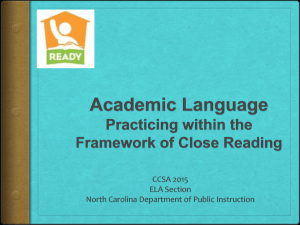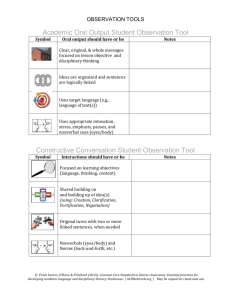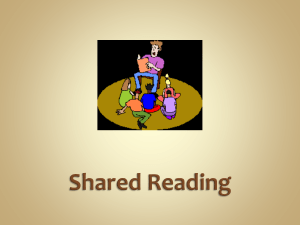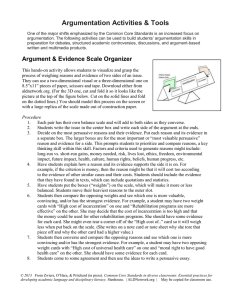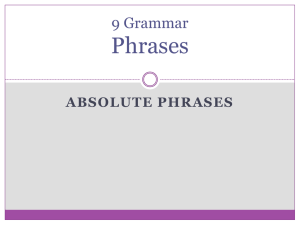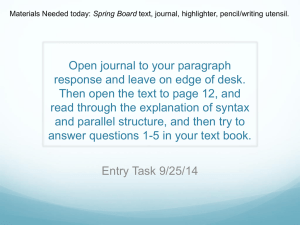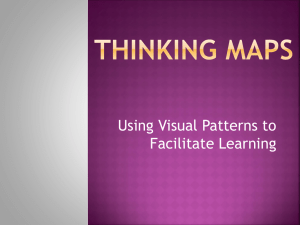Nov 13 2014 ELA Webinar
advertisement
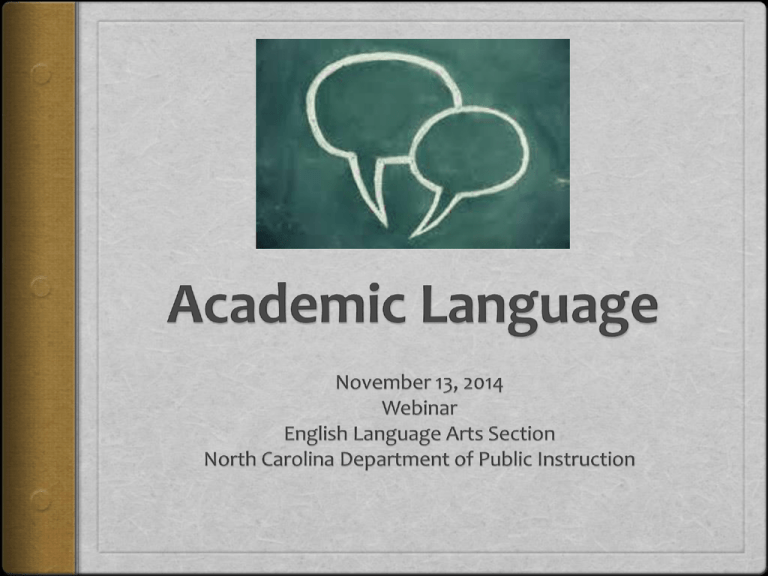
Resources http://www.livebinders.com/play/play?id=297779 Fall 2014 Academic Language http://elaccss.ncdpi.wikispaces.net/ The webinar ppt will be posted here! WHAT: More than vocabulary, terms, conventions and genres Academic Language is the language that is used in school to acquire new or deeper understanding of the content and communicate that understanding to others. WHY: “Close attention to words, sentences, and language use within the context of the text’s unfolding ideas initiates students into the academic language essential to becoming an educated person.” Academic Language is: the language used in the classroom and workplace the language of text the language of assessments the language of academic success the language of power Where is Academic Language supported in the Standards? Not so much taught… but acquired through interactions with complex texts and meaningful instructional conversations in which attention is drawn to the ways in which meaning relates to words, phrases, clauses in the texts. (L. Wong Fillmore) Three Dimensions of Academic Language Word/Phrase – Academic vocabulary, multi-meaning words, technical language Sentence – Academic language at this level is characterized by grammatical structures, conventions, mechanics, fluency Discourse – Oral and written. Could include lab reports, timelines, word problems, storytelling, sheet music 1. Word/Phrase Dimension Includes Academic Vocabulary – Tier 2 words Words in phrases are more meaningful than vocabulary in isolation Is only one aspect of Academic Language acquisition Teach word-learning strategies (roots, suffixes, prefixes) Foster word consciousness (an awareness of and interest in words and their meanings) Cross disciplinary terms Figurative expressions and multiple meanings Content vocabulary Affixes, roots, and transformations. O’Hara, Zwiers, Pritchard 2013 Figure out the meaning of new words and terms Use and clarify new words to build ideas or create products Choose and use the best words and phrases to communicate O’Hara, Zwiers, Pritchard 2013 Time and Attention More Time Abstract Words Words which are parts of semantic word families (develop, developed, developer, development) Words which represent an idea, event, concept unfamiliar to students Words likely to appear in future texts students will read Less Time Concrete Words Words not part of semantic word family and have single meanings (sofa, gregarious, indispensible) Words which are synonyms for ideas, or concepts students already know You Try It! Which more, which less? miniscule or strategy envied or majestic sheath or obstacle 2. Sentence Dimension This dimension involves putting words and phrases together in sentences. Academic texts include compound and complex sentences with multiple ideas. Readers can be challenged to find the primary idea of a sentence and notice how it is supported by other phrases and clauses. Sentence structure (compound/complex) and length Transitions and connectives Complex verb tenses and passive voice Pronouns and references O’Hara, Zwiers, Pritchard 2013 Craft sentences to be clear and correct Use a variety of sentence types, to clarify a message, condense information Combine ideas, phrases and clauses. O’Hara, Zwiers, Pritchard 2013 Juicy Sentences Lily Wong Fillmore and Maryann Cucchiara 2012 Begin with a juicy sentence! A juicy sentence: is tied closely to the Essential Question being explored is layered with academic Tier 2 vocabulary is long and embedded with main and dangling clauses, parts, and phrases is filled with figurative language that merits attention has content specific language functions There was nothing so very remarkable in that; nor did Alice think it so very much out of the way to hear the Rabbit say to itself, 'Oh dear! Oh dear! I shall be late!' (when she thought it over afterwards, it occurred to her that she ought to have wondered at this, but at the time it all seemed quite natural); but when the Rabbit actually took a watch out of its waistcoat-pocket, and looked at it, and then hurried on, Alice started to her feet, for it flashed across her mind that she had never before seen a rabbit with either a waistcoat-pocket, or a watch to take out of it, and burning with curiosity, she ran across the field after it, and fortunately was just in time to see it pop down a large rabbit-hole under the hedge. What’s next? What do I do with my juicy sentence? Read the sentence aloud (teacher or students) Copy the sentence (teacher or students) Deconstruct (chunk the sentence into parts) Discuss the meaning of the chunks Reconstruct See juicy sentences in action! Elementary Example Secondary Example 3. Discourse (message) Level Academic discourse is putting words and sentences (the other two dimensions) together to clearly communicate complex ideas. Clarity and coherence Register for participants and purposes Density of ideas and their relationships Message organization and structure (visuals, paragraphs) Organization of sentences O’Hara, Zwiers, Pritchard 2013 Create a logical flow of and connection between ideas, knowing how ideas develop and need to develop. Match language with purpose of message (Clear, complete, focused, logical, and appropriate to the discipline). Create, clarify, fortify, and negotiate ideas. O’Hara, Zwiers, Pritchard 2013 Instructional conversations work only if the conversations really are conversations. L. Wong-Fillmore Goals for Productive Discussion Goal One: Help individual students share, expand, and clarify their own thoughts. Goal Two: Help students listen carefully to each other. Goal Three: Help students deepen their reasoning. Goal Four: Help students engage with others’ reasoning. S. Michaels and C. O’Connor Writing and Academic Language Writing is a part of the Discourse Level. Follow close reading, juicy sentences, and conversations with a culminating task. Encourage students to use academic words and phrases in their writing. Use sentence starters. Writing should be text based. Dimensions of Academic Language and Grade-Level Examples Dimensions of Academic Language K-2 3-12 Word/Phrase Level Characters, text, titles, rhyming words Hyperlinks, stanzas, perspectives, root words Sentence Level Prepositional phrases, connectives, sequence words Metaphors, similes, analogies, allusions Discourse Level Folktales, blogs, rhetorical markers, storyboards Editorials, soliloquies, scripts, research reports Supporting Academic Language in the Classroom K-2 Dedicated peer-to-peer interaction time Shared/interactive writing Read alouds Visuals Teacher think alouds/modeling 3-5 “Do-it, Talk-it, Read-it, Write-it” – (Wierman & Strohl, 2012) With inquiry activities, students work together to do an activity, talk about it, refer back to the text or other sources and read about it, and finally report their observations and results in written form. This strategy allows students with different proficiency levels to work together to maximize their learning. It uses reading, writing and talk in authentic ways. 3-5 “Hot Seat” - (Lewison, Leland, & Harste, 2008) – is an interactive strategy that provides a way for all students to become a character in a story or event, answering questions posed by classmates about the character’s role and motivation for behaving, acting, or participating in particular ways. Theme Wall – (Academic Language in Diverse Classrooms) - identifies the broad thematic ideas or concepts from a unit or theme. Each broad concept includes vocabulary and text features that describe, connect with, or expand understanding of the concepts. Students use this academic language in their discussions, reading and writing throughout a unit. 6-8 Coding the Text A Agree ! Surprising or hard to believe F Figurative device Confirms what you thought ? Confused of question X Contradicts what you think D Disagree Hmmm New or interesting E4 Evidence for CE Cause/effect MP Main Idea or purpose B Bias * Important WA Weak argument VIP Very important Q Quotation to use or think about 6-8 Roundtable Write 1. Form groups of no more than five students, and provide each student with a different question or topic around a shared text. 2. Each student writes about the topic or responds to the question. 3. At the teacher’s signal, pass papers to a peer in the group. Then, students read what has been written with each adding his or her own thoughts in response to the question or topic. 4. Continue passing the responses until everyone has a chance to write on each paper, and each student ends up with his or her original paper. 5. Students write a summary synthesizing all the information on the page, including academic language found in the text on the topic or question they addressed. 6-12 Dynamically Introduce Academic Vocabulary http://www.vocabahead.com 9-12 Write with a Transition Handout http://writing2.richmond.edu/writing/wweb/trans1.html 9-12 Sentence Frames/Sentence Starters Author X contradicts herself. At the same time that she argues __________, she also implies __________. She argues __________, and I agree because __________. Her argument that __________ is supported by new research showing that __________. X insists, “__________.” As the prominent philosopher X puts it, “__________.” In her book, Book Title, X maintains that __________. X complicates matters further when she writes that __________. K-12 Communication Starters Resources for Academic Language Academic Language Infographic Cultivating Effective Reading Habits December 10, 2014 Close Analytic Reading integrates and further develops many of the elements that are needed to support each student in meeting the standards. This K-12 professional development focuses on practicing essential literacy components through close reading instruction. December 10, 2014 9:00-4:00 (NC Education Building, Raleigh - Room 150) Free registration! Lunch, substitutes, and travel expenses are not covered. To register: https://www.eventbrite.com/e/cultivating-effective-literacy-habitspracticing-within-the-framework-of-close-reading-tickets-13858353709 (Password: instruction) Contact Information Julie Joslin, Ed.D. Section Chief English Language Arts 919-807-3935 Julie.Joslin@dpi.nc.gov Anna Lea Frost, M.Ed. 6-8 English Language Arts Consultant 919-807-3952 Anna.Frost@dpi.nc.gov Lisa McIntosh, MSA K-5 English Language Arts Consultant 919-807-3895 Lisa.Llewellyn@dpi.nc.gov Kristi Day, M.Ed. K-5 English Language Arts Consultant 919-807-3928 Kristi.Day@dpi.nc.gov Angie Stephenson, M.Ed. 9-12 English Language Arts Consultant 919-807-3833 Angela.Stephenson@dpi.nc.gov
